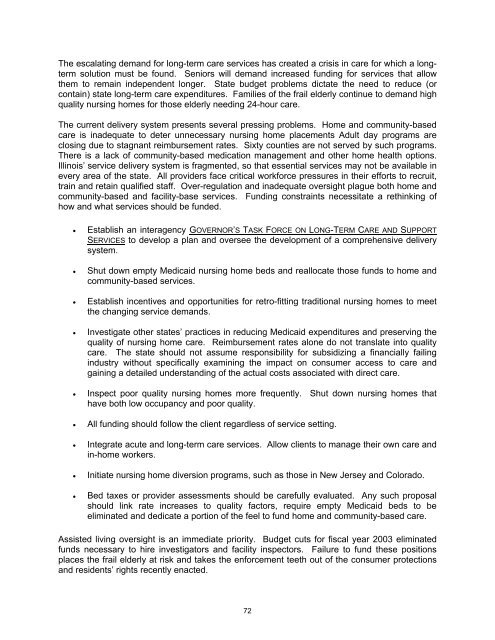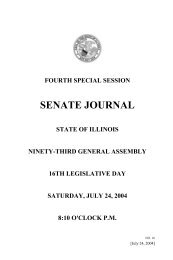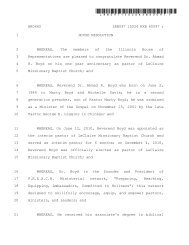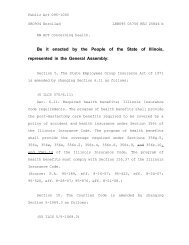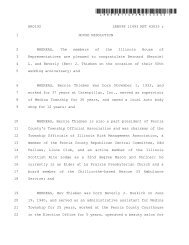Long-Term Care - Illinois General Assembly
Long-Term Care - Illinois General Assembly
Long-Term Care - Illinois General Assembly
You also want an ePaper? Increase the reach of your titles
YUMPU automatically turns print PDFs into web optimized ePapers that Google loves.
The escalating demand for long-term care services has created a crisis in care for which a longterm<br />
solution must be found. Seniors will demand increased funding for services that allow<br />
them to remain independent longer. State budget problems dictate the need to reduce (or<br />
contain) state long-term care expenditures. Families of the frail elderly continue to demand high<br />
quality nursing homes for those elderly needing 24-hour care.<br />
The current delivery system presents several pressing problems. Home and community-based<br />
care is inadequate to deter unnecessary nursing home placements Adult day programs are<br />
closing due to stagnant reimbursement rates. Sixty counties are not served by such programs.<br />
There is a lack of community-based medication management and other home health options.<br />
<strong>Illinois</strong>’ service delivery system is fragmented, so that essential services may not be available in<br />
every area of the state. All providers face critical workforce pressures in their efforts to recruit,<br />
train and retain qualified staff. Over-regulation and inadequate oversight plague both home and<br />
community-based and facility-base services. Funding constraints necessitate a rethinking of<br />
how and what services should be funded.<br />
• Establish an interagency GOVERNOR’S TASK FORCE ON LONG-TERM CARE AND SUPPORT<br />
SERVICES to develop a plan and oversee the development of a comprehensive delivery<br />
system.<br />
• Shut down empty Medicaid nursing home beds and reallocate those funds to home and<br />
community-based services.<br />
• Establish incentives and opportunities for retro-fitting traditional nursing homes to meet<br />
the changing service demands.<br />
• Investigate other states’ practices in reducing Medicaid expenditures and preserving the<br />
quality of nursing home care. Reimbursement rates alone do not translate into quality<br />
care. The state should not assume responsibility for subsidizing a financially failing<br />
industry without specifically examining the impact on consumer access to care and<br />
gaining a detailed understanding of the actual costs associated with direct care.<br />
• Inspect poor quality nursing homes more frequently. Shut down nursing homes that<br />
have both low occupancy and poor quality.<br />
• All funding should follow the client regardless of service setting.<br />
• Integrate acute and long-term care services. Allow clients to manage their own care and<br />
in-home workers.<br />
• Initiate nursing home diversion programs, such as those in New Jersey and Colorado.<br />
• Bed taxes or provider assessments should be carefully evaluated. Any such proposal<br />
should link rate increases to quality factors, require empty Medicaid beds to be<br />
eliminated and dedicate a portion of the feel to fund home and community-based care.<br />
Assisted living oversight is an immediate priority. Budget cuts for fiscal year 2003 eliminated<br />
funds necessary to hire investigators and facility inspectors. Failure to fund these positions<br />
places the frail elderly at risk and takes the enforcement teeth out of the consumer protections<br />
and residents’ rights recently enacted.<br />
72


